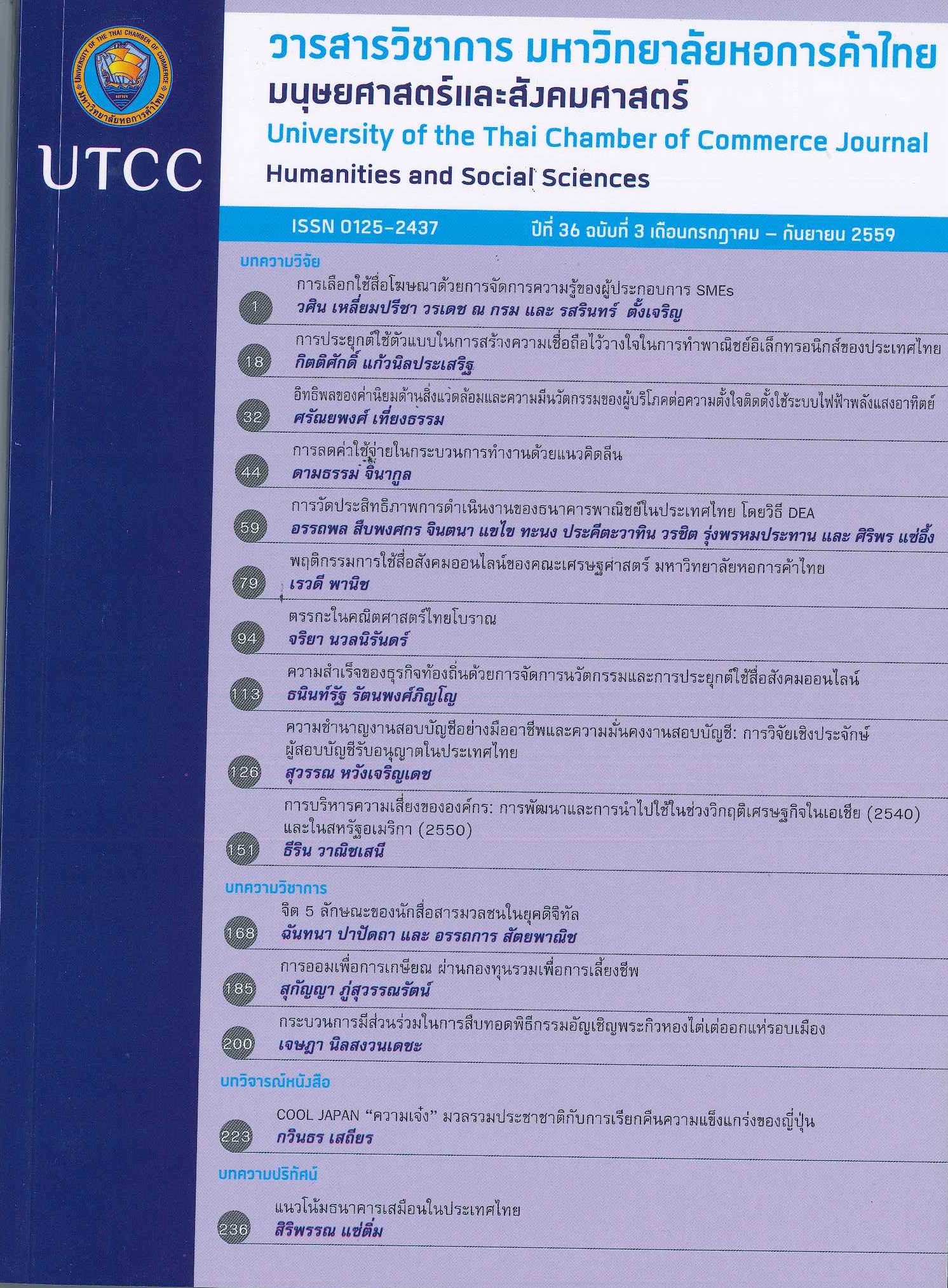Logic in Thai Traditional Mathematics
Main Article Content
Abstract
This research aims to examine characteristics of logic in Thai traditional mathematics, to compare them to those in Indian, Arabic and Chinese traditional mathematics and to compare them to Western mathematics at the beginning of nineteenth century. Theories used in this research are epistemology and ethnomathematics. The results show that the logic of Thai traditional mathematics is induction since its sources of premises stem from factual experiences. For logical inference, Thai traditional mathematics have no less than seven rules of calculation, i.e., elementary arithmetic, number crunching formulas, rule of three, arithmetic series, Cha-wang method, extraction of square and cube roots and a constant number for measuring area of a circle. Compared to other eastern mathematics, Thai traditional mathematics has the same logic as that of Indian, Arabic and Chinese mathematics, that is, all of them use inductive logic. In particular, most Thai computational rules were transmitted from Indian mathematicians; only a few rules were transferred into Thailand by ancient Chinese mathematicians. Furthermore, compared to Western mathematics, inductive logic used in Thai mathematics is still unable to state its conclusion as a general rule.
Article Details
ลิขสิทธิ์ของบทความ
ผลงานที่ได้รับการตีพิมพ์ถือเป็นลิขสิทธิ์ของมหาวิทยาลัยหอการค้าไทย ห้ามมิให้นำเนื้อหา ทัศนะ หรือข้อคิดเห็นใด ๆ ของผลงานไปทำซ้ำ ดัดแปลง หรือเผยแพร่ ไม่ว่าทั้งหมดหรือบางส่วนโดยไม่ได้รับอนุญาตเป็นลายลักษณ์อักษรจากมหาวิทยาลัยหอการค้าไทยก่อน
References
บาร์เกอร์, สตีเฟน เอฟ. 2537. ปรัชญาคณิตศาสตร์ Philosophy of Mathematics. แปลโดย สิริเพ็ญ พิริยจิตรกรกิจ. กรุงเทพมหานคร : สำนักงานคณะกรรมการวิจัยแห่งชาติ.
Bishop, Alan J. 1990. Western Mathematics : The Secret Weapon of Cultural Imperialism. [Online]. Available: https://www.sagepublications.com
Bostock, David. 2009. Philosophy of Mathematics. Oxford : Wiley-Blackwell.
Crilly, Tony. 2013. The Big Questions : Mathematics. Translated by Cathleya Duanggate. 2 nd ed. Bangkok : Matichon.
คริลลี่, โทนี่. 2556. 20 คำถามสำคัญของคณิตศาสตร์ (The Big Questions : Mathematics). แปลโดย แคทลียา ดวงเกตุ. พิมพ์ครั้งที่ 2. กรุงเทพมหานคร : มติชน.
D’ Ambrosio, Ubiratan. 2006. “The Program Ethnomathematics: A Theoretical Basis of the Dynamics of Intra – Cultural Encounters” The Journal of Mathematics and Culture
1,1 : 1-7.
De la Loubère, Simon. Description Du Royaume de Siam. Translated by Sant T. Komolbutra. 2 nd ed. Bangkok : Sripanya.
เดอ ลา ลูแบร์, มองซิเออร์. 2548. จดหมายเหตุ ลา ลูแบร์ ราชอาณาจักรสยาม. แปลโดย สันต์ ท. โกมลบุตร. พิมพ์ครั้งที่ 2. กรุงเทพมหานคร : ศรีปัญญา.
Eves, Howard. 1990. An Introduction to the History of Mathematics. 6th ed. Philadelphia, PA. : Saunders College Publishing.
Horwich, Paul. 2000. “Stipulation, Meaning, and Apriority” In Paul Boghossian and Christopher Peacocke (eds.), New Essays on the A Priori, pp. 11-42. Oxford : Clarendon Press.
Kither, Phillip. 1983. The Nature of Mathematical Knowledge. Oxford : Oxford University Press.
Ken, Won Lin. 2003. The Trade of Singapore 1819-1896. Selagor, Malaysia : Academe Art & Printing Services.
Nualnirun, Jariya. 2013. “King Rama III, King Pranangklao’s Philosophy of Trade.” University of the Thai Chamber of Commerce Journal 37, 1 : 81-95. (in Thai)
จริยา นวลนิรันดร์. 2556. “ปรัชญาการค้าของพระบาทสมเด็จพระนั่งเกล้าเจ้าอยู่หัว,” วารสารวิชาการ มหาวิทยาลัยหอการค้าไทย. 37, 1 : 81-95.
Naulnirun, Jariya. 2012a. “Thai Ancient Mathematics : Epistemological View in the 19th Century.” School of Humanities and Social Science Journal, Rangsit University 7, 12 : 34-43.
(inThai).
จริยา นวลนิรันดร์. 2555ก. “คณิตศาสตร์ไทยโบราณ : มุมมองทางญาณวิทยาในศตวรรษที่ 19.” วารสารมนุษยศาสตร์และสังคมศาสตร์ มหาวิทยาลัยรังสิต 7, 12 : 34-43.
Nualnirun, Jariya. 2012b. “Thai Traditional Arithmetic as a Common Subject or an Advanced One that have not been Perceived in the Western World.” Art & Culture Magazine 33,
5 : 140-155. (in Thai).
จริยา นวลนิรันดร์. 2555ข. “เลขเป็นโทโบราณว่าหรือสุดยอดวิชาที่ไม่ปรารถนาให้โลกรู้,” ศิลปวัฒนธรรม. 33, 5: 140-155.
Omthuan, Kittipakorn, Klomjit, Chantana, and Inprasitha, Maitree . 2007. “An Investigation of Mathematical Ideas in Khon Kaen Tie-Dyed Fabric Silk Process.” KKU RESEARCH
JOURNAL (GRADUATE STUDIES) 7, 1 : 146-155. (in Thai).
กิตติปกรณ์ อัมเถื่อน, ฉันทนา กล่อมจิต และไมตรี อินทร์ประสิทธิ์. 2550. “การศึกษาแนวคิดทางคณิตศาสตร์ในขั้นตอนการผลิตผ้าไหมมัดหมี่” วารสารวิจัย มข. 7,1 : 146-155.
Pallegoix, Jean-Baptiste. 2009. Description du Royaume ou Siam. Translated by Sant T. Komolbutra. 4th ed. Bangkok : Sripanya.
ปาลเลกัวซ์, มงเซเญอร์. 2552. เล่าเรื่องกรุงสยาม. แปลโดย สันต์ ท. โกมลบุตร. พิมพ์ครั้งที่ 4” กรุงเทพมหานคร : ศรีปัญญา.
Na Nakorn, Prasert. 2006. “Ancient Terms in Thai Mathematics.” In Miscellaneous History pp. 299-301. Bangkok : Matichon. (in Thai).
ประเสริฐ ณ นคร. 2549. “ศัพท์โบราณในคณิตศาสตร์ของไทย.” ใน ประวัติศาสตร์เบ็ดเตล็ด. หน้า 299-301. กรุงเทพมหาตร : มติชน.
Shapiro, Stewart. 2000. Thinking about Mathematics : The Philosophy of Mathematics. New York : Oxford University Press.
Temple, Robert. 2011. The Genius of China. Translated by. Pongsarn Meekhunsombat. 2nd ed. Bangkok : Matichon.
เทมเพิล, โรเบิร์ต. 2554. ต้นกำเนิด 100 สิ่งแรกของโลก-The Genius of China. แปลโดย พงศาล มีคุณสมบัติ. พิมพ์ครั้งที่ 2. กรุงเทพมหานคร : มติชน.
Thailand. Fine Arts Department.1970. Prathom Kor Ka Patom Kor Ka Had Arn Pathom Mala Agsornniti Ancient Thai Texts. Thonburi : Silpabannakarn (in Thai).
กรมศิลปากร. 2513. ประถม ก กา ปถม ก กาหัดอ่าน ปฐมมาลา อักษรนิติ แบบเรียนหนังสือไทย. ธนบุรี : ศิลปาบรรณาคาร.


